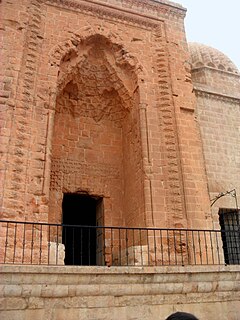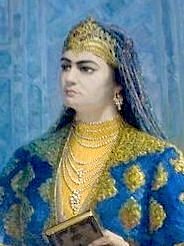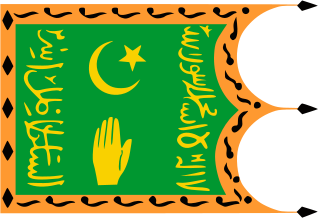
Badakhshan is a historic region comprising parts of what is now northeastern Afghanistan, eastern Tajikistan, and the Tashkurgan county in China. The name is retained in Badakhshan Province, which is one of the 34 provinces of Afghanistan and is located in North-East Afghanistan. Much of historic Badakhshan lies within Tajikistan's Gorno-Badakhshan Autonomous Region located in the south-eastern part of the country. The music of Badakhshan is an important part of the region's cultural heritage.

Russian Turkestan was the western part of Turkestan within the Russian Empire, comprising the oasis region to the south of the Kazakh Steppe, but not the protectorates of the Emirate of Bukhara and the Khanate of Khiva.

Abdullah Khan (1533/4–1598), known as "The old Khan", was an Uzbek ruler of the Khanate of Bukhara (1500–1785). He was the last Shaybanid Dynasty Khan of Bukhara, from 1583 until his death.

The Khanate of Bukhara was an Uzbek state from the second quarter of the 16th century to the late 18th century in Central Asia. Bukhara became the capital of the short-lived Shaybanid empire during the reign of Ubaydallah Khan (1533–1540). The khanate reached its greatest extent and influence under its penultimate Shaybanid ruler, the scholarly Abdullah Khan II.

The Kazakh Khanate was a successor of the Golden Horde existing from the 15th to 19th century, located roughly on the territory of the present-day Republic of Kazakhstan. At its height, the khanate ruled from eastern Cumania to most of Uzbekistan, Karakalpakstan and the Syr Darya river with military confrontation as far as Astrakhan and Khorasan Province, which are now in Russia and Iran, respectively. The Khanate was later weakened by a series of Oirat and Dzungar invasions, devastating raids and warfare. These resulted in a decline and further disintegration into three Jüz-es, which gradually lost their sovereignty and were incorporated to the expanding Russian Empire. Its establishment marked the beginning of Kazakh statehood whose 550th anniversary was celebrated in 2015.

Nasrullah Khan or Nasr-Allah bin Haydar Tora was the Emir of Bukhara from 1827 to 1860. His father was emir Haydar Tora (1800–1826). After Haydar's death Hussain bin Haydar Tora came to power. He died two months later and was succeeded by Umar bin Haydar Tora, who in 1827 was succeeded by Nasrullah.
`Alimqul was a warlord in the Kokand Khanate, and its de facto ruler from 1863 to 1865.

The Bukhara operation (1920), was a military conflict fought between the Russian Soviet Federative Socialist Republic and the Young Bukharians against the Emirate of Bukhara. The war lasted between 28 August and 2 September 1920, ending in the defeat of the Bukhara Emirate, which was instead replaced by the RSFSR controlled Bukharan PSR.

Syr-Darya Oblast was one of the oblasts of the Russian Empire was part of Russian Turkestan. Its center was Tashkent.

The Battle of the Chirciq River was fought between Sultan Mahmud Khan of Moghulistan and Sultan Ahmed Mirza, the Timurid ruler of Samarkand & Bukhara in 1488 CE over the city of Tashkent. The Moghuls decisively defeated the Timurids as a result of the defection of 3,000 Uzbeks under the command of Muhammad Shaybani Khan.

Sayid Muhammad Khudayar Khan, usually abbreviated to Khudayar Khan, was a Khan of Kokand who reigned between 1845 and 1875 with interruptions. He was the son of Shir Ali Khan. During the reign of Khudayar Khan, the Khanate was suffering from a civil war and from interventions of the Emir of Bukhara. Subsequently, the Russian invasion into Central Asia first forced the Khanate to become a vassal of the Russian Empire, and in 1876 the Khanate was abolished as a result of the suppression of an uprising. In 1875, Khudayar Khan, who took a pro-Russian position, during the uprising had to flee to Orenburg in Russia. He died in exile.
Pūl was a historical Russian currency that circulated in Russian Turkestan. Pūls were used in Golden Horde, Afghanistan, Bukhara, Chagatai Khanate, Kokand Khanate, Dzungar Khanate, and other Eurasian principalities, it was a copper coin of very small denomination, 1/60 of an altyn.

The Russian conquest of Central Asia took place in the second half of the nineteenth century. The land that became Russian Turkestan and later Soviet Central Asia is now divided between Kazakhstan in the north, Uzbekistan across the center, Kyrgyzstan in the east, Tajikistan in the southeast and Turkmenistan in the southwest. The area was called Turkestan because most of its inhabitants spoke Turkic languages with the exception of Tajikistan, which speaks an Iranian language.
Muhammad Ali Khan, commonly referred to as Madali Khan, was the official Khan of Kokand from c. 1822 to 1842. He became the official ruler of Kokand at the age of 14 after his father Muhammad Umar Khan died of an illness in 1822, although some sources claim his mother Mohlaroyim was really in charge due to Madali's young age and inexperience.
Shir Ali Khan was the Khan of Kokand from June 1842 to 1845. He was the father of Muhammad Khudayar Khan and Muhammad Malla Beg Khan, and a cousin of Umar Khan and Alim Khan. After a popular revolt against the Bukhari occupation of Kokand, Nasrullah Khan and the puppet governor he installed, Ibrahim-Dadhoh was expelled to Khujand. Shir Ali struggled to revive the khanate from the brief but destructive occupation by Bukhari forces. In 1843 he managed to re-annex Tashkent to the khanate and take control of several other portions of land that were once part of the Kokand Khanate.




















